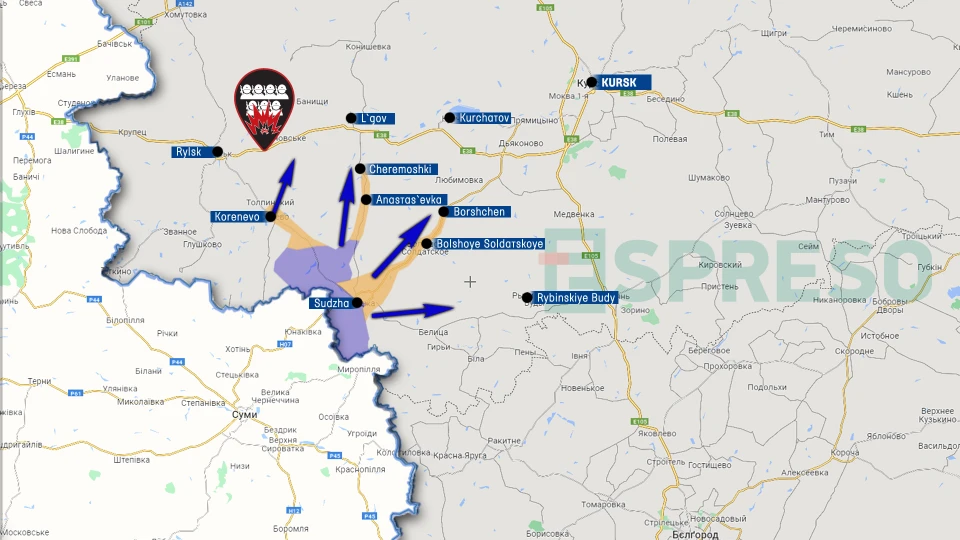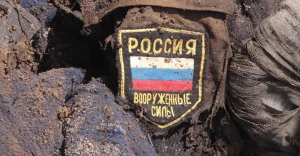
Destruction of Russian troops in Kursk region: powerful blow, new operation and innovative solution for Ukraine's army. Serhiy Zgurets' column
Due to the Ukrainian Armed Forces' operation in Kursk region, there is a certain decrease in hostilities in the Kharkiv sector and near Chasiv Yar
Ukrainian Armed Forces' operation in Kursk region
Ukrainian forces attacked a Russian military convoy near Rylsk in the Kursk region. It is reported that there were 14 trucks in the convoy, some of the vehicles were loaded with personnel. Dozens of Russians are known to have been killed. The total number of dead may exceed a hundred Russian soldiers. This is one of the results of the Ukrainian army's strikes on Russia's reserves, which Russia has begun to move to the Kursk region.
Since August 6, a well-planned offensive operation of the Ukrainian Armed Forces with a tactical scale, with the potential for operational and strategic consequences, has been going on for four days, and despite all the risks, it looks quite effective. Taking into account all the limitations that currently exist in the information space regarding the reporting of this offensive operation of the Armed Forces, we can assume that the width of the front in the Kursk region is about 20 kilometers and the depth of the penetration is up to 35 kilometers. The offensive is taking place in three directions, although four directions are visible on the map.
The Ukrainian military has completed the capture and blockade of Sudzha, where two Russian battalions were encircled. Now they are advancing towards the village of Myrne, which is located in the direction of Kursk from Sudzha. On the western flank, the movement and control of the area of Koreneve continues, where the Russian troops tried to fight back. We are observing fighting for the village and around it. Most likely, Ukrainian forces will move towards Rylsk, where a Russian convoy was attacked.

The central offensive is to advance to Lgov, where the movement is most dynamic. This is a town on the way to the Kursk nuclear power plant. Yesterday we talked about the fighting in this area near Anastasyevka, and now it is fighting near the village of Kromskiye Byki. It's 15 km to Lgov, and then, if it's possible to get to the highway, then from there to the east along the road about 25 km to Kurchatov, where the Russian nuclear power plant is located.
During the four days of offensive operations, the Ukrainian Armed Forces secured a 400-420 km area. This is more than in the two months of the offensive last year in the south. However, these 400 or 420 kilometers do not mean that the Armed Forces are in full control of this area, because there is no solid front line in the Kursk region. There is a maneuver war going on, where mobile groups of the Armed Forces on armored vehicles move quickly along the roads, not staying in settlements. However, there was a video where Ukrainian APCs and Strykers were seen moving quickly through mined fields. That is, the practice of conducting such assault operations has been worked out and gives powerful results. The goals and purpose of these actions of Ukrainian mobile units operating in the Kursk region are quite obvious. This is the destruction of Russia's combat potential, manpower, and equipment, including a significant number of prisoners who are now being brought to the Armed Forces. There are no constraining battles on the part of the Russian enemy, because four days have passed, and Russia is still going to move its forces here, but it uses mainly Lancet drones and even Iskander missiles for counterattacks. There is a video of Iskander strikes on Ukraine's equipment, which indicates an impulsive reaction, because it is inappropriate to use such a weapon to destroy armored vehicles. Aviation, by the way, is not being used actively enough. The Russians are probably afraid of the Ukrainian air defense system.
Goals of Ukrainian Armed Forces
The operational goal is to force Russia to move some of its forces and reserves from other areas to the Kursk region. This, by the way, is already happening. In addition to the Wagner fighters, the Pyatnashka brigade, which fought at Chasiv Yar, is being redeployed there. There is also information about Russia's forces being moved from the Kharkiv direction. It is noteworthy that there is a certain lull in the fighting in the Kharkiv sector and near Chasiv Yar, and even the use of aviation has decreased. That is, this operation has an indirect impact even on those areas where the Russian army is active. As for strategic effects, this is the dominant component in this story. In fact, this is an attempt to slow down or stop the Russian momentum in offensive operations, to take the initiative in certain areas, which is extremely important. This operation demonstrates the ability of the military leadership and well-coordinated units of the Armed Forces to conduct non-linear, asymmetric military operations.
This action fits into the new logic of war of attrition. For a long time, it was believed that the Russians had more equipment and personnel, so Russia had an advantage in a war of attrition. But now we see that, along with the formation of reserves, preparation of reserves and fortifications, other actions are important that can shock the Russian enemy and win victories where it least expects it. To act in such a way as to suppress their morale, undermine their sense of security and strengthen the internal morale of Ukrainian society and the Armed Forces, and this operation can demonstrate that. But, of course, we do not know whether this risky operation will be a great success or a big mistake, as some experts are trying to predict.
Strategic perspectives of operation in Kursk region
The operation destroyed the myth that Russia is always on the offensive. Now the situation is changing, and I think Ukraine will hold this foothold in the near future. There are geographical prerequisites for this, there are opportunities to gain a foothold there. But in order to hold it, Ukraine will now implement a concept that is somewhat reminiscent of NATO's combined operations, when the enemy will be hit with long-range weapons where he tries to accumulate forces to attack this area.
The second component is to provide cover for Ukrainian troops through air defense systems. This is not an easy challenge, but these two components - long-range munitions and air defense systems - can turn this bridgehead into a site where Russia's troops approaching this area will be destroyed. In fact, this will create further strategic and even political effects that may be needed during negotiations with or even without the Russian enemy. Holding this territory will be a significant disturbance to Russia, forcing it to draw forces and reserves from other directions. If there are too many Russian forces, it is possible to withdraw from this area, because the strategic effect of these measures already has an impact on other front lines. This also creates a socio-political resonance that is absolutely necessary at this stage of the war. The peculiarities of the operation in the Kursk region had a component that concerned the means of disrupting communication systems and the use of electronic warfare by the Ukrainian side.
Anatolii Khrapchynskyi, deputy director general of an electronic warfare company and aviation expert, assessed the situation in the Kursk region in terms of the use of electronic warfare.
"I think we can talk about coherence and interaction here, when the use of drones under the operation of our own electronic warfare means does not allow the enemy to use attack drones. We see a qualitative combination and communication between flight vehicles, i.e. UAVs, and electronic warfare equipment," he said.
The company is known for developing a whole line of electronic warfare products. Khrapchynskyi outlined the electronic warfare equipment that is currently in the greatest demand among Ukrainian military and law enforcement agencies.
New technologies to protect against attack drones
"At this stage, the military is more interested in personal protective equipment, i.e. those that can be installed on a car or near an object to protect against FPV drones. The next step, which is now being actively developed, is large systems that can operate over long distances and suppress a variety of capabilities, from simple radio communications to sophisticated drones that can fly over long distances and operate even under electronic warfare. The main goal is to combine all the means into a single system that would allow them to work together and provide high-quality protection, detection and suppression," Khrapchynskyi said.
According to him, tactical-level equipment that can be put in a trench or installed on a vehicle is a solution that is enabled by additional detection systems. Large systems that can operate at a distance of up to 35 km already have solutions that allow them to automatically work on air targets. This means the capabilities to detect and immediately suppress, for example, an UAV or other aerial object.
"Such systems can work against ballistic missiles, conventional missiles and guided bombs, affecting their capabilities. For this purpose, it is necessary to additionally install classical radar systems that allow detecting any airborne object," he added.
Thus, the company has developed a solution that can detect enemy drones and simultaneously suppress them after detection. This solution can be supplied not only to the Armed Forces, but also to critical infrastructure, which will reduce the accuracy of attack drones. This solution has already been tested, confirmed its characteristics, and is now at the stage of codification. Over time, it is likely to be codified by NATO and will be able to be procured by any security forces.
Innovative solutions for detecting and suppressing air targets
"The company's capacities allow us to produce these systems in dozens or hundreds per year, depending on the predictability of procurement: "We have also occupied a niche in classical radar, which allows us to detect any airborne objects not only using radio signals but also classical methods. It should be noted here that production is now being expanded and new promising directions are being taken. For example, we are currently cooperating with a very well-known European radar company to create a joint product for detecting air targets," Khrapchynskyi said.
The company solves air target detection using not only radio reconnaissance, but also conventional radar, by creating a separate radar, which is then integrated with the means of suppressing an enemy drone. This is with full software that enables the addition of destruction means to this complex.
The aviation expert explained what targets can be seen with the new radar: "If we are talking about Mavic, for example, then yes, we will be able to see. We can see an FPV drone, it all depends on the distance. For example, we will be able to see a conventional Shahed attack drone at a distance of about 30 km, as well as Orlan. Therefore, it will be possible to decide whether we suppress with electronic warfare or work with destruction means such as those FPV drones."
"When we talk about a range of 30 kilometers, we mean a low-altitude radar field that is actively used by the enemy. They are trying to lower the missiles and raise the attack drones more, although initially the Russians used low altitudes to fly the same Shahed. That's why we're talking about 30 kilometers, which is actually due to the small target, the geography of the land, and all these elements that significantly impose some limitations. Classical locations provide for the detection of any air targets at an altitude of 500 meters and at distances of up to 600 km. But here we are talking about a low-altitude radar field that can overlap depending on the surface, because there are buildings, mountains, hills, riverbeds, and this reduces our capabilities to a hundred kilometers. That is, to protect an object, we will need more means to ensure that we can see any target," he said.
Russia is moving to other ranges of FPV drones, to lower frequency bands, and electronic warfare equipment, such as shotguns, which were purchased in bulk earlier, are now unsuitable for these purposes. The company, which also offers shotguns and anti-drone solutions, is responding to these new challenges.
"We have long been making a block system that allows us to quickly change the range and replace it with another. The latest generation of our generator, which we develop and manufacture ourselves, allows us to change the frequency range of this generator through software that is on the mobile phone. In other words, we are talking about a broadband generator that can create some interference at different frequencies. For example, if the enemy changes its frequencies, this is not a threat, there will be no need to hand over the equipment to the manufacturer for a physical change. It will be enough to simply change the frequencies at the program level," Khrapchynskyi said.
- News












































